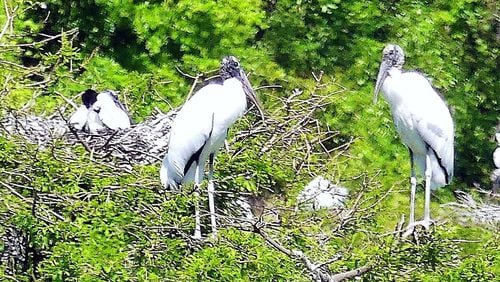Thirty-five years ago, wildlife scientists feared that the wood stork, a large wading bird of Southeast swamps, would be extinct by 2000 unless the species made a remarkable recovery.
The lanky, bald-headed bird, North America’s only breeding stork species, was put on the federal Endangered Species List. State and federal wildlife managers in Georgia and elsewhere then undertook intense conservation efforts to prevent the bird from passing into oblivion.
Those efforts paid off. The wood stork was upgraded in 2014 from endangered to threatened, an indication that it no longer faces extinction — another great success story of the Endangered Species Act.
That was evident last week when we visited the 2,800-acre Harris Neck National Wildlife Refuge in coastal McIntosh County, about 50 miles south of Savannah. In a noisy, smelly rookery, hundreds of wood storks were tending white, downy babies in nests built in trees and shrubs surrounding the refuge’s 50-acre Woody Pond, and on the small, bushy islands that dot the pond.
The man-made pond, fed by well water, has played — and continues to play — a pivotal role in the stork’s recovery. In the late 1980s, biologists undertook several efforts, including designing and building artificial nest platforms and planting cypress trees, to lure the storks there and protect them from predators.
Now, with more than 400 pairs of nesting wood storks, Woody Pond is Georgia’s largest stork rookery and one of the most important in the Southeast, says the U.S. Fish and Wildlife Service.
The refuge is now called a “stepping stone” for bolstering stork populations. Many of the stork babies reared there this spring, for instance, will disperse north and perhaps help establish new breeding colonies elsewhere in the Southeast.
IN THE SKY: From David Dundee, Tellus Science Museum astronomer: The Eta Aquarid meteor shower will reach a peak of 60 meteors per hour this weekend — in the southeast from about 3 a.m. until dawn. Mercury is low in the east just before dawn. Venus is in the west at dusk and sets about two hours later. Mars rises out of the east around midnight and will appear near the moon tonight. Jupiter is in the east at dusk. Saturn rises in the east around midnight.
Wood Stork (Mycteria americana)
Status: Threatened (Endangered Species List); total current breeding population estimated to be 16,000 adults.
Description: Large, long-legged wading bird standing little over 3 feet; 5-foot wing span; white plumage except for black wings and short black tail; bald, gray head and neck; long, decurved black bill.
Feeding: Primarily small fish 1 to 6 inches long; feeds in 6-10 inches of water with its long, opened beak partially submerged, snapping it shut when it touches prey; shuffles feet and flashes wings to stir up prey; may use thermals to soar as far as 80 miles from nesting to feeding areas.
Reproduction: Tends to nest in rookeries near ponds with alligators, which keep predators such as raccoons at bay; 2-5 eggs laid between March and May; fledges occur in July and August; average two fledglings per nest during good season.






